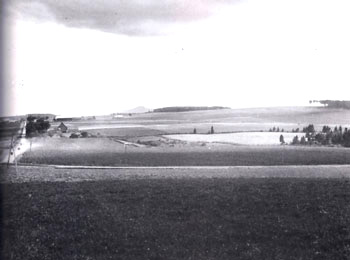B A C K T H E N
Heart of the Valley

Photo: National Archives
August 1908, Presque Isle. The heart of the fertile Aroostook Valley was as handsome as it was productive. Horse-drawn traffic raises dust on the road, which is lined by telephone poles; Presque Isle village had telephone service by 1893.
There is an unmistakable touch of fall in the air, and before we know it our brief summer will have lapsed into cold weather. But it has been… a hummer… in cooperation with… the husbandman and the stimulating tonic of some forty thousand tons of phosphate, the soil and the sunshine of this fertile region have turned over to our people hundreds of thousands of tons of hay and bushels of grain, and the present prospect is that a crop of potatoes will be raised that will be of the best quality and well up to the maximum in numbers of bushels. —The [Presque Isle] Star-Herald, Aug. 20, 1908.
The year 1908 indeed proved to be a good one for potato farmers, with a bumper crop and high prices. Maine was said to lead the world in potato yield—the national average was eighty-six bushels per acre, while Presque Isle’s yield was probably three hundred. Price per barrel held up between $1.25 and $1.50. In Aroostook costs were figured at about $50 to $60 per acre. Figuring one hundred barrels to the acre, we can understand the appearance in the Valley of grand houses, lofty barns, and telephone poles. Ninety percent of the deposits in the seven Valley banks was said to be owned by farmers.
But 1906 and ’07 had not been good years. 1906 had been a bumper year across the nation, and prices in Aroostook fell to twenty-five cents, just about enough to make hauling the crop to the starch factories worthwhile. This led to the construction of many potato storage houses, which allowed the farmer to hold back some of his crop. In 1907 prices were low, labor high, and due to heavy rains, much of what had been a good crop rotted in the ground. Many farmers spent the winter in the woods cutting railroad ties. On October 24 Caribou’s Aroostook Republican reported:
The farmers rush and hurry, life and tug and wallop their tired horses over the muddy roads, with mud to the bellies of the horses and the jigger wagon axles dragging, hauling their rotten potatoes to T. H. Phair’s starch factory by the covered bridge on Madawaska Stream for 35 cents a barrel. With long faces they finger the frozen potatoes or handle the frostbitten October oats. Many are talking of selling out and going to California. A tough winter on the granger.
Local observer W. T. Ashby wrote:
A moth flies into a lighted candle and burns its wings. It does not get wise and go back and sit down, but keeps buzzing the candle until it is disabled and ruined. Last year the farmers were badly singed at the potato business and this year they are seriously burned. The chances are that 99 out of 100 will plant next spring more potatoes than ever and vote the Republican ticket in the fall. This is just what the railroads, commission merchants, phosphate trust, horse dealers, and dealers in agricultural implements and many others want them to continue doing, and they will. — The [Caribou] Aroostook Republican, Oct. 3 1907.
Then 1908 came along, with “money as plentiful as water” and farmers paying up their old bills. Potato fever was rampant once again; it was said saltpeter could not cure it. A Presque Isle farm that sold for $5,000 three years before sold for $12,000; a 320-acre farm that sold for $12,500 five years before sold for $30,000. Aroostook’s curse was the boom, not the bust.
The photo is a study of crop rotation. The land in the immediate foreground is in timothy and clover; having been hayed, it is now being plowed, probably for next year’s potatoes. (August plowing, while not good from the standpoint of erosion, was thought to reduce weeds, and also occupied otherwise idle time between harvests.)
The field across the road is in potatoes; the light-colored field beyond is in grain, likely oats. The usual rotation was one year of potatoes, followed by a year of grain, which, in turn, served as a nurse crop for the timothy and clover sowed with it. The grass and clover, which were hayed for a couple of years, added both nitrogen (from the clover, a legume) and organic (from the clover, a legume) and organic matter to the soil in preparation for the next round of potatoes. Having little livestock manure, Aroostook farmers were necessarily also strong believers in the heavy use of commercial fertilizers.
Text by William H. Bunting From A Days Work, Part 2, A Sampler of Historic Maine Photographs, 1860-1920 , Part II. Published by Tilbury House Publishers, Gardiner, Maine, 800-582-1899
